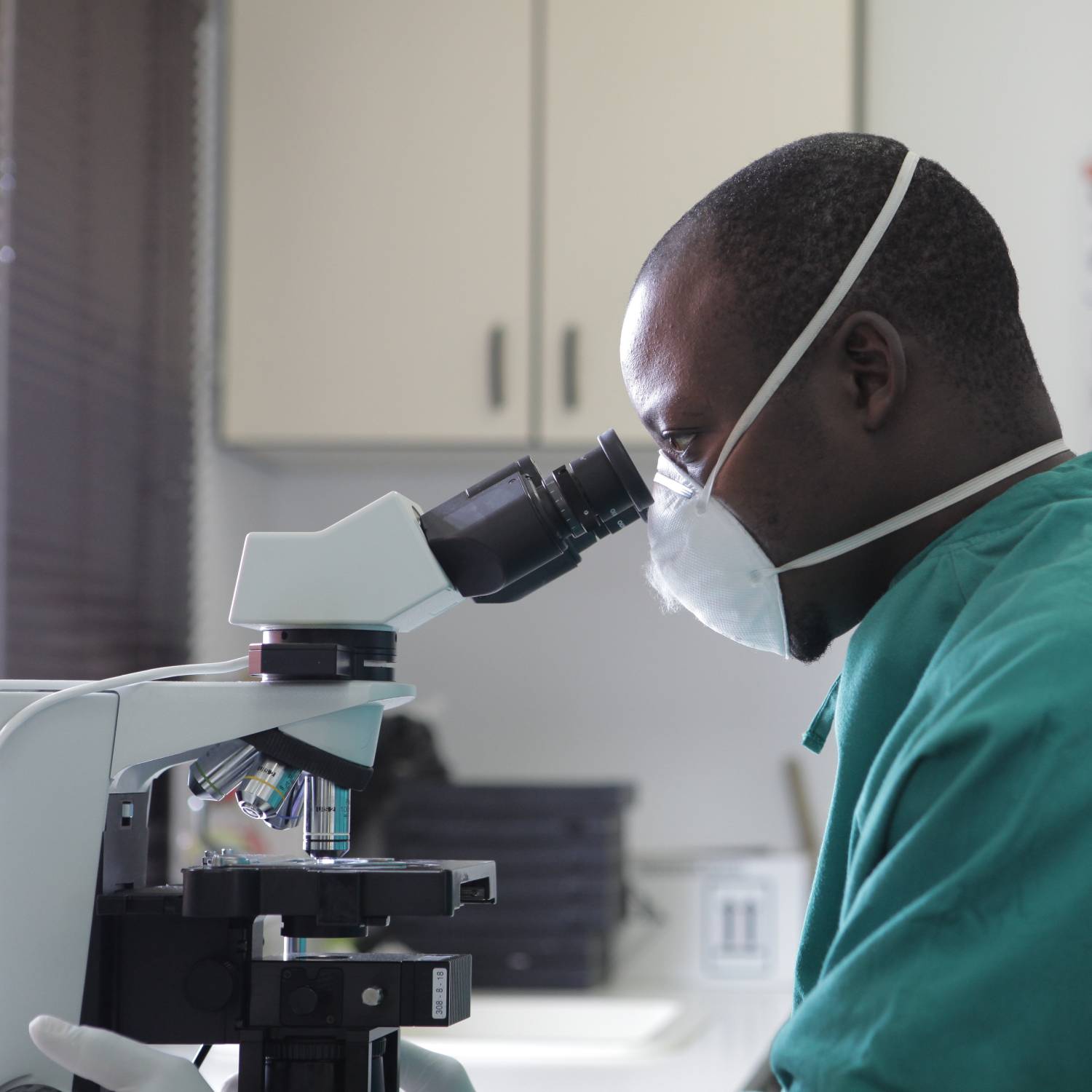ABOUT THE
TB Dictionary
A consensus TB dictionary to unify the language we speak
Tuberculosis terminology must be adaptable so that it remains relevant despite the changing landscape of knowledge and with the constant revision and evolution of TB concepts.
The TB dictionary has been developed through a systematic approach, guided by evidence and expert review to develop a consensus list of terms and definitions to harmonize TB-related vocabulary. This dictionary will be periodically updated to reflect the evolving nature of our TB understanding. We hope this open-access glossary represents a useful resource that allows the community of TB researchers, policymakers, funders, and those affected by TB to unify around a common understanding of TB-related vocabulary with the ultimate goal of improving overall communication and harmonizing efforts in TB control.

INTRODUCTION
In recent decades, scientific outputs in the field of TB have experienced exponential growth,1 propelled by renewed investments and unprecedented advances in research, including the development of molecular diagnostics, improved treatment regimens, and a quest for new vaccine candidates.2-5 Some of these advances have broadened our understanding of the spectrum of TB, which challenge long-standing concepts and introduce novel terms for application across research and control efforts. However, the introduction of new, inconsistently defined terms or the modification of previous definitions over time may lead to confusion, misunderstanding, and inconsistency in the utilization of TB-related terminology.
For instance, the broadly used term “latent TB infection” has been used to both denote the presence of Mycobacterium tuberculosis (Mtb) infection in the body as well as to define past immunological exposure to Mtb. The World Health Organization (WHO) has recently deemed it inaccurate and recommends using “TB infection” instead.6 The term “active tuberculosis” is also frequently used to denote a person with disease caused by Mtb, in contrast to the traditional term “latent TB infection”. However, we now know that “latent TB” is not truly “inactive TB” or even “latent” as understood in other fields. Similarly, the widely used case definitions for pediatric TB (“probable TB, “possible TB”, “unconfirmed TB”) have undergone multiple revisions by different authors, who use different terms to describe the same condition.7 Moreover, emerging terms or concepts have garnered substantial attention in recent years, such as “incipient TB” or “subclinical TB”, yet have different meanings and definitions in the literature and in policy-related documents.8-9
Recognizing the dynamic nature of vocabulary and lexicology, particularly in the evolving realm of scientific ventures that aim to challenge established concepts and definitions, there is a need to harmonize and streamline the terminology associated with TB. The development of a living dictionary could serve as a reference for people interested in TB, including those engaged in TB control and research, or those directly affected by this condition. It is hoped that such a resource would contribute to clarity, consistency, and effective communication within the field.
Driven by this motivation, a diverse group of independent researchers, public health officers, and TB survivors, with different backgrounds, expertise, and geographic origins collaborated to establish the first edition of the Global TB Dictionary.
REFERENCES
1. Cobelens F, Suri RK, Helinski M, Makanga M, Weinberg AL, Schaffmeister B, et al. Accelerating research and development of new vaccines against tuberculosis: a global roadmap. Vol. 22, The Lancet Infectious Diseases. Elsevier Ltd; 2022. p. e108–20.
2. Gill CM, Dolan L, Piggott LM, McLaughlin AM. New developments in tuberculosis diagnosis and treatment. Breathe. 2022;18(1).
3. MacLean E, Kohli M, Weber SF, Suresh A, Schumacher SG, Denkinger CM, et al. Advances in molecular diagnosis of tuberculosis. Vol. 58, Journal of Clinical Microbiology. American Society for Microbiology; 2020.
4. Ruhwald M, Carmona S, Pai M. Learning from COVID-19 to reimagine tuberculosis diagnosis. Lancet Microbe. 2021 May 1;2(5):e169–70.
5. Stop TB Partnership. Words Matter: Suggested language and usage for tuberculosis communications. Geneva; 2022.
6. World Health Organization. Development of a Target Product Profile (TPP) and a framework for evaluation for a test for predicting progression from tuberculosis infection to active disease 2017 WHO collaborating centre for the evaluation of new diagnostic technologies. Geneva; 2017.
7. Drain PK, Bajema KL, Dowdy D, Dheda K, Naidoo K, Schumacher SG, et al. Incipient and Subclinical Tuberculosis: a Clinical Review of Early Stages and Progression of Infection. American Society for Microbiology. 2018.
8. Migliori GB, Ong CWM, Petrone L, D’ambrosio L, Centis R, Goletti D. The definition of tuberculosis infection based on the spectrum of tuberculosis disease. Breathe. 2021 Sep 1;17(3).
9. Graham SM, Cuevas LE, Jean-Philippe P, Browning R, Casenghi M, Detjen AK, et al. Clinical Case Definitions for Classification of Intrathoracic Tuberculosis in Children: An Update. Clinical Infectious Diseases. 2015 Oct 15;61(suppl_3):S179–87.
Process
We first conducted a comprehensive review of TB-related literature (published between January 2000 and December 2022) to identify terms and definitions associated with TB. All Global TB Programme (WHO) publications were selected as a main source for extraction of terms, as they commonly represent an international reference. We also reviewed publications from The International Union Against Tuberculosis and Lung Disease (The Union) and The Centers for Disease Control and Prevention (CDC) from the United States. In addition, we conducted a systematic search in PubMed using the keywords “tuberculosis” AND “definitions” OR “glossary” OR “term” to identify articles whose main objective was to discuss definitions of TB terms and concepts, or those that contained glossaries.
Terms were initially screened for their relevance to TB and were excluded if they were not TB-specific (e.g., “culture” or “adolescent”). Terms were
We first conducted a comprehensive review of TB-related literature (published between January 2000 and December 2022) to identify terms and definitions associated with TB. All Global TB Programme (WHO) publications were selected as a main source for extraction of terms, as they commonly represent an international reference. We also reviewed publications from The International Union Against Tuberculosis and Lung Disease (The Union) and The Centers for Disease Control and Prevention (CDC) from the United States. In addition, we conducted a systematic search in PubMed using the keywords “tuberculosis” AND “definitions” OR “glossary” OR “term” to identify articles whose main objective was to discuss definitions of TB terms and concepts, or those that contained glossaries.
Terms were initially screened for their relevance to TB and were excluded if they were not TB-specific (e.g., “culture” or “adolescent”). Terms were classified into categories and distributed for review by a panel of TB experts who were blinded to all other reviews, and contributed to the dictionary as associate editors. Each term and definition was assessed by two reviewers, who could reject, amend, or accept each term and definition. Conflicting opinions were solved by consensus or, if needed, by the discussion with a third reviewer. All amendments underwent a final review for cohesion and consistency by the editors. In case of conflicting opinion, the editors met to discuss and find consensus. In the last quarter of 2023, there were two final review iterations with all associate editors. The consensus terms and definitions were compiled into a glossary, representing the first edition of the Global TB Dictionary. The glossary was refined to ensure alignment with the Stop TB Partnership’s Words Matter language guide, and reviewed by two TB survivors to ensure that the language is acceptable to the TB-affected community. 13
classified into categories and distributed for review by a panel of TB experts who were blinded to all other reviews, and contributed to the dictionary as associate editors. Each term and definition was assessed by two reviewers, who could reject, amend, or accept each term and definition. Conflicting opinions were solved by consensus or, if needed, by the discussion with a third reviewer. All amendments underwent a final review for cohesion and consistency by the editors. In case of conflicting opinion, the editors met to discuss and find consensus. In the last quarter of 2023, there were two final review iterations with all associate editors. The consensus terms and definitions were compiled into a glossary, representing the first edition of the Global TB Dictionary. The glossary was refined to ensure alignment with the Stop TB Partnership’s Words Matter language guide, and reviewed by two TB survivors to ensure that the language is acceptable to the TB-affected community.
Have a look at the detailed methodology, here.

Unifying the language
we speak
Throughout the document screening and editorial review, there were several notable examples of misaligned terms and definitions which had several common themes:
- new terms lacking consistent understanding in the literature and used in different ways
- older terms not aligning with current scientific understanding or with currently accepted non-stigmatizing language
- definitions used inconsistently in publications from the same organization and even from the same year.
The use of ‘tuberculosis’
The most extensive discussions within the editorial team revolved around the term “tuberculosis” itself, which has been used differently, often followed by the word “disease” (“TB disease”) and/or preceded by the word “active” (“active TB”). The term “tuberculosis” has been used both to refer to the disease (as opposed to infection with Mtb) or to the broader field of Mtb interactions within the human body. For the former meaning, mimicking the lexicology used in other diseases (HIV infection is the cause of AIDS, or SARS-CoV-2 is the cause of COVID-19), our recommendation is to use the term “Mtb infection” to refer to the traditional terms “TB infection” or “latent TB infection”, and the term “tuberculosis” to refer to he disease stage caused by Mtb.
As this dictionary aims to be a participatory and iterative process, new or amended terms and definitions can be proposed on the TB Dictionary webpage for inclusion in subsequent editions of the dictionary. These suggestions, alongside new terms from the literature, will be reviewed on an annual basis by the editorial team, and the dictionary will be subsequently updated.
